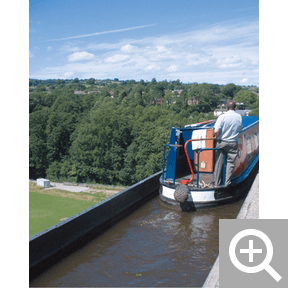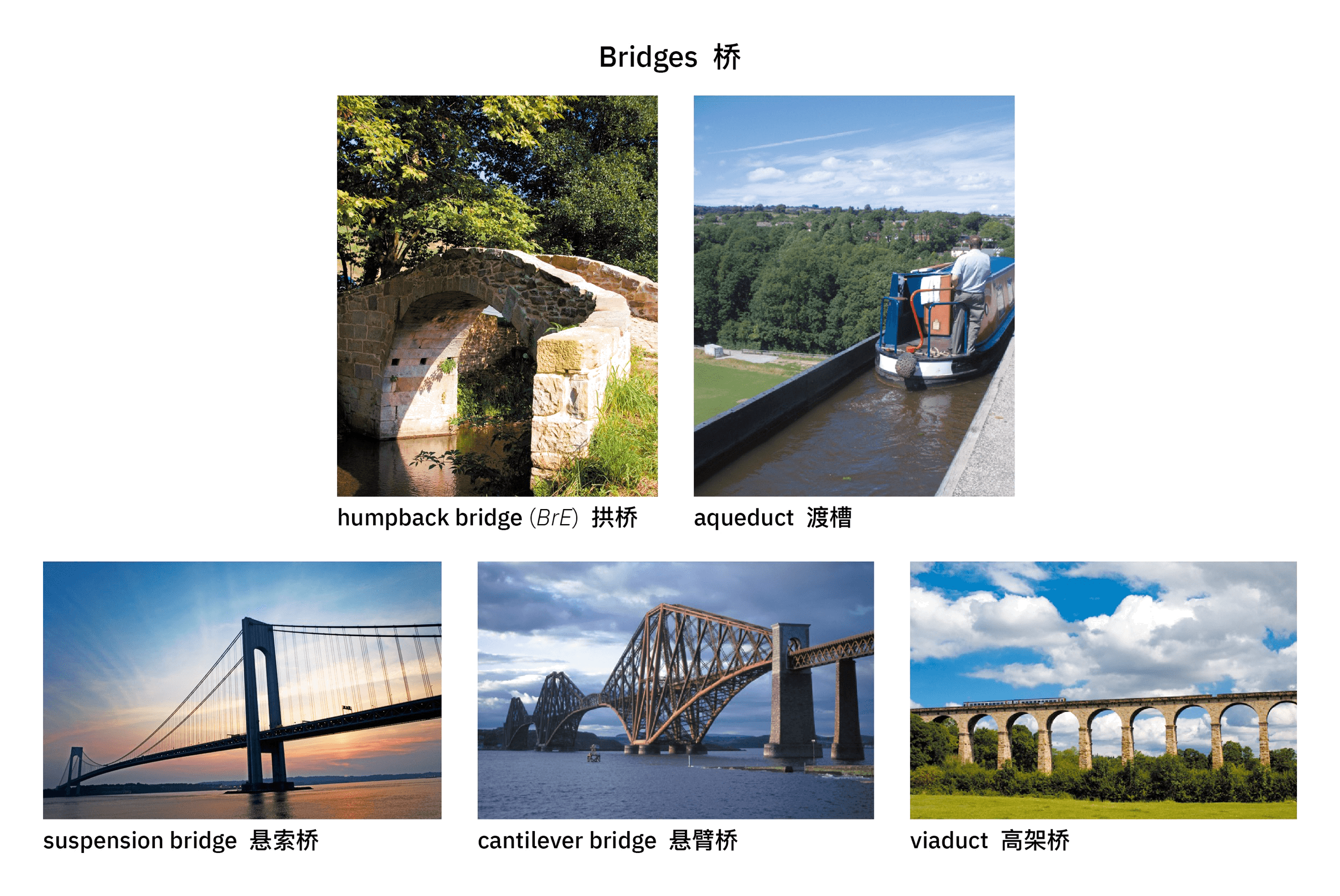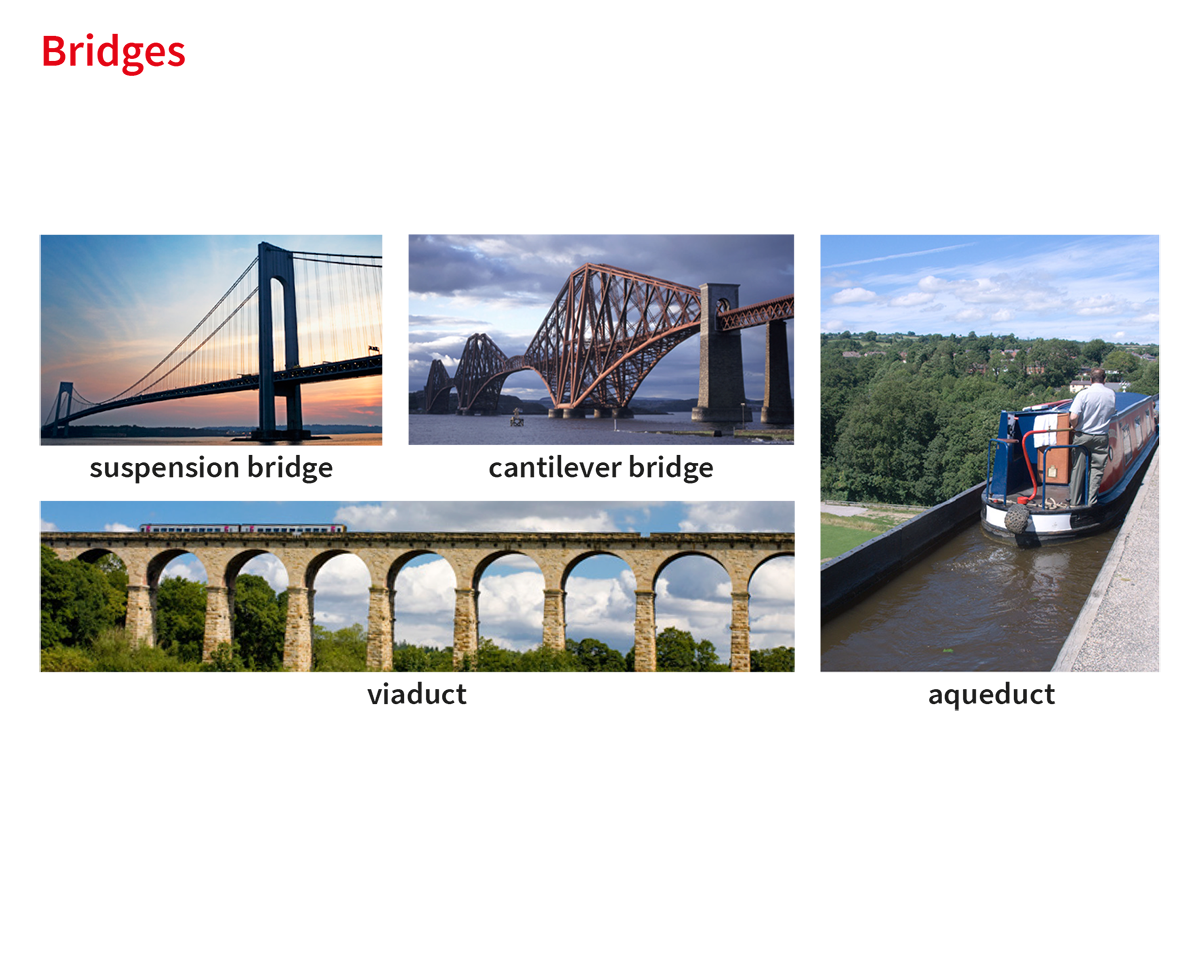a structure for carrying water, usually one built like a bridge across a valley or low ground 渡槽;高架渠 
 Culture canalscanalsBritain's canals (= man-made channels of water for boats to travel along) were built in the late 18th and early 19th centuries, at the start of the Industrial Revolution. They provided a cheap and convenient means of transport for heavy goods, especially between the mining and industrial centres of the Midlands and north-west England. Coal, grain, clay and other materials were transported on narrowboats, also called barges, that were pulled along by horses walking along a towpath next to the canal. Many miles of channel had to be dug, with some sections passing through tunnels or over aqueducts (= long, high bridges across valleys). Hundreds of locks were built to enable boats to go up or down a hill. A flight (= series) of 20 or 30 locks was needed on some steep sections.In the US canals were used for a short period to transport goods to areas where there were no large rivers. The most famous, the Erie Canal in New York State, ran from Buffalo on Lake Erie to Albany on the Hudson River and connected New York with Ohio, Michigan and Pennsylvania. Mules, not horses, were used to pull the barges. The growth of the railway in the 1840s soon took business away from the canals, but the canal system played an important role in expanding trade and encouraging people to move west.After the railways were built, many canals were filled in. In Britain especially, canals that still exist have become popular with people wanting a quiet country holiday away from traffic. Old narrowboats have been fitted with motors and converted to provide attractive holiday accommodation. Speed is limited on canals so the pace is slow and relaxing. Some locks are operated by lock-keepers, but many are worked (= opened and closed) by people on the boats. Going through a flight of locks is seen as part of the fun. At night, people moor their boats at the side of the canal. Canals are also popular with people fishing and walking on the towpath. Many pubs are built next to canals and attract people enjoying a canal holiday or having a day out.In Britain, some people live in narrowboats and stay most of the time on a particular stretch of canal. These houseboats are often painted in bright colours, with pictures of flowers on the side. On the flat roof there are sometimes traditional pots painted with similar designs.Word Originmid 16th cent.: from obsolete French (now aqueduc), from Latin aquae ductus ‘conduit’, from aqua ‘water’ + ducere ‘to lead’.
Culture canalscanalsBritain's canals (= man-made channels of water for boats to travel along) were built in the late 18th and early 19th centuries, at the start of the Industrial Revolution. They provided a cheap and convenient means of transport for heavy goods, especially between the mining and industrial centres of the Midlands and north-west England. Coal, grain, clay and other materials were transported on narrowboats, also called barges, that were pulled along by horses walking along a towpath next to the canal. Many miles of channel had to be dug, with some sections passing through tunnels or over aqueducts (= long, high bridges across valleys). Hundreds of locks were built to enable boats to go up or down a hill. A flight (= series) of 20 or 30 locks was needed on some steep sections.In the US canals were used for a short period to transport goods to areas where there were no large rivers. The most famous, the Erie Canal in New York State, ran from Buffalo on Lake Erie to Albany on the Hudson River and connected New York with Ohio, Michigan and Pennsylvania. Mules, not horses, were used to pull the barges. The growth of the railway in the 1840s soon took business away from the canals, but the canal system played an important role in expanding trade and encouraging people to move west.After the railways were built, many canals were filled in. In Britain especially, canals that still exist have become popular with people wanting a quiet country holiday away from traffic. Old narrowboats have been fitted with motors and converted to provide attractive holiday accommodation. Speed is limited on canals so the pace is slow and relaxing. Some locks are operated by lock-keepers, but many are worked (= opened and closed) by people on the boats. Going through a flight of locks is seen as part of the fun. At night, people moor their boats at the side of the canal. Canals are also popular with people fishing and walking on the towpath. Many pubs are built next to canals and attract people enjoying a canal holiday or having a day out.In Britain, some people live in narrowboats and stay most of the time on a particular stretch of canal. These houseboats are often painted in bright colours, with pictures of flowers on the side. On the flat roof there are sometimes traditional pots painted with similar designs.Word Originmid 16th cent.: from obsolete French (now aqueduc), from Latin aquae ductus ‘conduit’, from aqua ‘water’ + ducere ‘to lead’.
🔍 牛津詞典 🎯
🔍 朗文詞典
🔍 劍橋詞典
🔍 柯林斯詞典
🔍 麥美倫詞典
🔍 韋氏詞典
檢索以下詞典:
(Mr. Ng 不推薦使用 Google 翻譯!)
最近搜尋:
- subidea 58
- snippier 62
- aborigen 55
- from then on 63
- herdlike 61
- furor 140
- presidium 111
- Hard 360
- squeegee 220
- dormancy 131
- balance-sheet 78
- Nutrients 99
- floorshow 81
- sprain 135
- bliss 585
- rectifies 58
- tuition 774
- Sedentary 127
- squishier 62
- shaftless 57
- dislustre 51
- uninsured 79
- distended 159
- unfavourable 329
- Wandering 49
- TBD 473
- witness 779
- civilized 149
- explain away 152
- oxidatively 63
- cock-a-hoop 145
- onlooker 147
- cake 1083
- canada 171
- intemperance 178
- globe-artichoke 85
- slothful 93
- minima 70
- aura 264
- fifo 83
- byline 209
- abcs 103
- Shrub 128
- eat 524
- Astrology 84
- octet 125
- cornfield 115
- undergod 48
- presidia 54
- unhabitable 61
- inject 147
- bear up 159
- ecuadorian 131
- rutting 79
- scrupulously 136
- necropolis 107
- Alsatian 104
- Platinum 113
- plausibly 108
- chapless 57
- Presbyterian 125
- yawn 622
- Regarded 87
- tealight 76
- Evil 290
- glossist 52
- formerly 176
- alarmism 99
- ent 231
- seismology 124
- deal-out 66
- solstice 160
- florence 81
- enhanced 152
- patinaed 46
- at bat 139
- habitats 100
- managing 57
- gun-shy 117
- outcheat 46
- inwardness 73
- bag lady 173
- unpotted 53
- despisal 62
- DECLARATION 126
- goldfish 158
- crepuscular 160
- joyrider 88
- consumed 86
- Aggrieve 70
- drabbish 54
- chimeric 85
- thrill 826
- recensor 54
- dwarfish 90
- pandar 64
- jalapeno 57
- act on 199
- good-for-nothing 114
- rankless 47
- undereat 47
- rosalind 73
- pretrim 52
- foothold 333
- Shank 191
- lesbic 43
- rustable 52
- primogeniture 88
- gibbing 69
- digerati 127
- scattery 63
- prigger 53
- sessions 74
- uncake 46
- craggier 72
- aurae 94
- Specious 60
- lester 64
- foggiest 106
- Caution 142
- Jackpot 151
- holyhead 84
- Dialogue 336
- Portugal 155
- poultry 354
- Shorten 347
- demijohn 113
- In the red 52
- Brooding 57
- millinery 103
- kit 355
- blameworthy 211
- Biomass 129
- martina 67
- arborio 88
- succoth 82
- bourkha 72
- taglike 52
- weedier 56
- atomics 60
- outsulk 55
- Shimmer 66
- Way Out 85
- sealift 77
- stabler 65
- balding 303
- bulimia 181
- fattest 101
- day-job 106
- pay off 144
- mod con 74
- vegetal 80
- cattail 82
- Stellar 42
- thrifty 142
- plurals 73
- whip up 173
- william 73
- Alcohol 253
- sporoid 56
- tunning 47
- sift out 114
- retrial 103
- primers 56
- dinkier 77
- cryonic 50
- gamiest 66
- REELECT 59
- mingles 58
- saguaro 68
- malcolm 94
- Toronto 79
- Isolate 204
- cicadae 73
- Apostle 65
- rookish 50
- foghorn 166
- earless 94
- sprawly 58
- baltics 54
- narcolepsy 108
- slabbed 56
- Neglect 299
- natalie 67
- veinous 66
- phyllis 72
- soupcon 54
- Queasy 204
- pugged 69
- dirt 753
- Scholar 449
- ear-splitting 207
- piece 366
- attenuate 182
- Joke 241
- harridan 107
- Judgement 216
- underwater 109
- prequel 92
- standout 219
- visualize 261
- Chanting 14
- among other things 61
- bugle 161
- devalued 106
- inferiority 109
- pawer 58
- saturnine 138
- contributor 261
- afara 167
- clomb 61
- flea market 189
- Tariff 227
- blowlamp 170
- lopped 60
- glossy 205
- Chris 119
- breeziest 76
- zygote 117
- Pavlovian 143
- sign out 16
- staged 54
- chateau 227
- sophie 58
- bugger all 123
- heaving 58
- ledger 159
- doxies 58
- variation 676
- kronur 71
- merlin 114
- sanguine 152
- solace 137
- forthwith 158
- dragee 55
- carrie 83
- myelin 85
- pastis 85
- PARCEL 166
- Strait 207
- lungyi 60
- excise 221
- act-up 155
- disclose 703
- peeper 104
- fix up 179
- orchid 254
- be, keep, etc. in touch (with something) 81
- lobster 575
- Abduct 113
- advent 263
- cadcam 72
- coring 92
- biller 67
- Dazzle 75
- glazed 204
- hit it 48
- Exhort 57
- pretest 62
- ginger 144
- Chaste 123
- eyewall 74
- Chores 98
- naught 111
- iphone 59
- Crown 221
- parley 85
- aslef 86
- gov 131
- herbalism 109
- spammy 74
- kaikai 52
- denver 69
- disclosed 3
- sitten 58
- hypnotherapy 124
- deed 739
- reenactment 85
- aerospace 181
- basket 253
- scattered 108
- wheelhouse 115
- hawala 69
- inmesh 57
- janet 66
- avocet 78
- giles 71
- milken 55
- gewgaw 98
- mottled 309
- Shock 315
- Bat 132
- hydros 60
- Longish 38
- comoran 129
- fontal 72
- Pad 209
- mavis 78
- snail 120
- Dissipated 152
- Edible 180
- blast 731
- vehicle 825
- wave 784
- miaou 74
- anthropocentricity 69
- clarinetist 111
- appetizing 304
- well-reasoned 81
- speccy 72
- Crest 213
- deeds 95
- kevin 65
- Nursery 127
- cooey 59
- committee 967
- silver 625
- tion 66
- Brag 286
- bong 193
- woad 85
- dirk 194
- censorious 154
- wlan 73
- nuer 64
- lgbtq 127
- Minimum wage 126
- maund 79
- boxing 337
- drowsiness 71
- durst 55
- bella 87
- Ideas 80
- lorna 68
- Goody 138
- czech 123
- depressed 411
- grime 285
- respectful 591
- Epsom 99
- perth 82
- skimp 229
- altho 64
- Sheer 98
- Promise 233
- Neat 423
- ictus 71
- shute 47
- class action 185
- twill 94
- Paper 258
- sage 323
- Snide 72
- pasteurised 120
- teenager 701
- shiftless 137
- faithful 762
- fume 389
- tupik 79
- heading 674
- slaphappy 95
- drave 64
- jello 191
- Bully 261
- Ranks 68
- UNTIL 147
- Gecko 113
- Notify 365
- condensation 268
- END 293
- one 190
- kenya 108
- Behold 196
- penal 123
- hindi 114
- rosie 66
- anklet 171
- reckless 310
- daggy 169
- thingamajig 84
- mechanic 737
- holography 58
- indomitable 139
- shist 56
- cleat 184
- blase 97
- aver 253
- belch 167
- crabs 103
- penchant 116
- Commonplace 168
- supertanker 99
- bps 143
- activate 279
- forthright 247
- hotelier 97
- wangling 57
- kiwi fruit 124
- body check 80
- glance off 172
- Clap 264
- crinkly 174
- posterity 178
- cottage pie 138
- Sweep over 82
- tactless 369
- echocardiogram 67
- Video 283
- philia 63
- Democrat 86
- neck 1092
- omnidirectional 168
- ashkenazic 62
- Aliquot 31
- Hundred 85
- stack 742
- exemplary 208
- paiute 88
- mockingbird 210
- contempt 673
- secrecy 155
- circuit board 159
- Lawn 143
- Negligible 205
- grained 145
- undertaker 100
- Red Flag 83
- meridian 89
- Thoughts 120
- pep talk 125
- officially 107
- Words used to describe changes 67
- cio 113
- unexpected 759
- prompt 701
- Fella 252
- Only too 49
- potshot 85
- Arraign 220
- Generation 324
- cocky 482
- Harlem 70
- do over 202
- wholefood 332
- fast 626
- milieu 236
- ballad 204
- dysphoria 74
- sob 752
- freight 798
- foreshadowing 77
- formidable 250
- attribute 665
- Technology 388
- interfering 110
- disclaimer 177
- categorise 128
- deportment 115
- Double 139
- Seasonable 218
- reversible 164
- firefight 108
- categorize 300
- dump truck 176
- instruct 652
- commanding 165
- transistor 660
- exclamation mark 165
- ham-fisted 151
- virtual 716
- endoskeleton 165
- stock market 85
- Choose 230
- riboflavin 85
- April Fool's Day 134
- lobotomies 52
- unwarranted 123
- the Fourth of July 243
- reprimand 287
- braeburn 74
- countersign 156
- jordan 124
- soroptimist 72
- curl up 160
- addressee 184
- renewable 296
- humorous 729
- Tune in 48
- machine gun 129
- discourage 769
- thunderless 48
- pin money 132
- complain 735
- flying squad 147
- carousal 82
- fifth-columnist 104
- contrition 146
- buttress 219
- go in for 187
- insensibility 136
aqueduct
Bridges and dams: aqueduct, arch, boom...
👨🏻🏫 Mr. Ng 牛津詞典 📚 – oxford.mister5️⃣.net
切換為繁體中文

